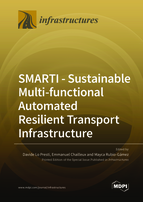SMARTI - Sustainable Multi-functional Automated Resilient Transport Infrastructure
A special issue of Infrastructures (ISSN 2412-3811).
Deadline for manuscript submissions: closed (15 February 2020) | Viewed by 54226
Special Issue Editors
Interests: sustainability; life cycle assessment; recycling; bitumen; asphalt; smart infrastructure; road pavements; railway trackbeds
Special Issues, Collections and Topics in MDPI journals
Interests: material characterization; materials; mechanical properties; polymers; construction; materials engineering; civil engineering; materials chemistry; DSC; green chemistry technology; biobinder
Interests: asphalt pavements; design and mechanical characterization; sustainable and smart materials and technologies for transportation infrastructure; fatigue behavior; long lasting asphalt materials; environmental assessment; LCA
Special Issues, Collections and Topics in MDPI journals
Special Issue Information
Dear Colleagues,
The world’s surface transport network has developed over thousands of years, emerging from the need of providing more comfortable trips to Roman soldiers to the modern infrastructure enabling modern vehicles to travel at high speed. However, in the past two decades, the world has changed very quickly in terms of population growth, mobility, and business trades, creating greater traffic volumes and demand for minimal disruption to users, but also challenges such as climate change and more extreme weather events. At the same time, developments in digitalisation, vehicle design, mobile and wireless communications, and sensor technologies continue apace. It is within this environment and in close consultation with key stakeholders that this Special Issue will focus on providing an opportunity for scientific dissemination towards the paradigm shift to SMARTI, transport infrastructures conceived with the following features:
- SUSTAINABLE: Designed by using improved decision frameworks aimed at improving durability, maximising recycling, and minimising environmental, economic, and social impacts;
- MULTI-FUNCTIONAL: Conceived not only for transport purposes and works towards the optimisation of land use by adding energy harvesting capabilities;
- AUTOMATED: Equipped with low-cost wireless sensors to allow pro-active communication towards more intuitive use and simplified management;
- RESILIENT: Conceived to self-repair and be adaptable to changes due to natural and anthropogenic hazards.
Dr. Davide Lo Presti
Dr. Emannuel Chailleux
Dr. Mayca Rubio
Guest Editors
Manuscript Submission Information
Manuscripts should be submitted online at www.mdpi.com by registering and logging in to this website. Once you are registered, click here to go to the submission form. Manuscripts can be submitted until the deadline. All submissions that pass pre-check are peer-reviewed. Accepted papers will be published continuously in the journal (as soon as accepted) and will be listed together on the special issue website. Research articles, review articles as well as short communications are invited. For planned papers, a title and short abstract (about 100 words) can be sent to the Editorial Office for announcement on this website.
Submitted manuscripts should not have been published previously, nor be under consideration for publication elsewhere (except conference proceedings papers). All manuscripts are thoroughly refereed through a single-blind peer-review process. A guide for authors and other relevant information for submission of manuscripts is available on the Instructions for Authors page. Infrastructures is an international peer-reviewed open access monthly journal published by MDPI.
Please visit the Instructions for Authors page before submitting a manuscript. The Article Processing Charge (APC) for publication in this open access journal is 1800 CHF (Swiss Francs). Submitted papers should be well formatted and use good English. Authors may use MDPI's English editing service prior to publication or during author revisions.
Keywords
- smart infrastructure
- sustainability
- resilience
- land use optimisation
- transport








